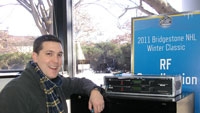HBO Sports 'Road to the Winter Classic' rolls on Lectrosonics

For its recent look inside one of the NHL’s great rivalries, “Penguins/Capitals: Road to the NHL Winter Classic,” HBO Sports engaged Bexel Broadcast Services for production assistance. The four-week series, used to promote the NHL’s annual Winter Classic outdoor game, needed to capture dialog among players, coaches and referees. To do this, a sizeable Lectrosonics wireless setup was divided among multiple ENG crews.
The wireless equipment included 16 Lectrosonics SMD miniature belt-pack transmitters and 16 UCR411 receivers. This equipment was used by the four ENG crews assigned to follow the players and referees, and each crew had responsibility for four wireless microphones. Additionally, six Lectrosonics UM400 belt-pack transmitters were used for camera hops from the audio technician’s bag, feeding audio to the cameras. These were paired with additional UCR411 receivers, for a total of 22 RF channels. To provide isolated individual record tracks for use in subsequent editing, Bexel used a redundant receiver setup, consisting of several Lectrosonics Venue mainframes stocked with VRT receiver modules.
Project engineer Ted Marvin of Bexel discussed the challenges of the project.
“HBO placed microphones on players, coaches and refs and used additional mics for wireless effects,” he said. “In this environment, there was a lot of perspiration, rough physical contact, and at the Winter Classic, it even rained. It was essential that our wireless equipment be durable and resistant to moisture, have high power output and range to handle the distances between players and receivers, and provide long battery life.”
Lectrosonics’ frequency agility and selectivity in crowded RF environments allowed all the wireless mics to operate within the same frequency block, which was a key tactic that Bexel wanted to employ. With all frequencies accessible, an ENG operator could grab audio from a targeted player by simply changing the receiver frequency.
Marvin was also impressed with the system’s high-performance limiter and related circuitry.
“Sometimes, there was excessive crowd noise and the electronics maintained a very clean signal. Other times, such as in the locker room or on the bus, it was relatively quiet and we needed a low noise floor to properly capture the audio. This all had to happen without having access to the gain controls on the transmitters. Here, too, Lectrosonics’ performance was exceptional,” he said.
The professional video industry's #1 source for news, trends and product and tech information. Sign up below.
